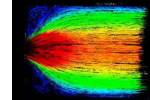
|
Reactive processing
Mechanically blending polymers with different characteristics can give new materials with some of the properties of both parents. This is a standard method for generating value-added plastics such as rubber-toughened adhesives and high impact polystyrene. The disadvantage with simple mechanical blending, however, is that the intimacy of the blend is limited. A number of techniques have been developed to improve the stability of mirco-phase morphologies, and so increase the intimacy of the blend, including:
To date the ability to use these techniques in practice has been limited, as only an empirical understanding of the processes is available. The IRC is now conducting a broad range of experimental and theoretical modelling studies aimed at quantifying the interaction between flow, reactivity and structure leading to the development of stable micro-phase structures. These include:
Whilst in the past the importance of blends has been in their mechanical properties, increased control over the process offers new product possibilities. Materials with sub-micron to nano-scale structures, have been demonstrated to have valuable optical and electronic properties. The ability to blend polymers at these scale lengths potentially offers access to new 'smart' and 'reactive' products. |
|
|
|
|
© The Polymer IRC 2004, design www.cookandkaye.co.uk /
Webmaster /
Disclaimer /
Privacy The IRC includes the University of Bradford, the University of Durham, the University of Leeds and the University of Sheffield. | |

